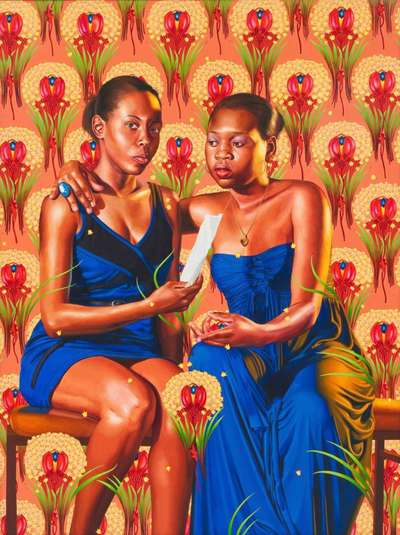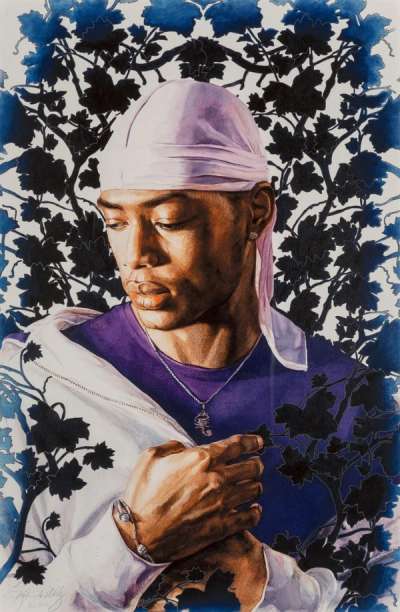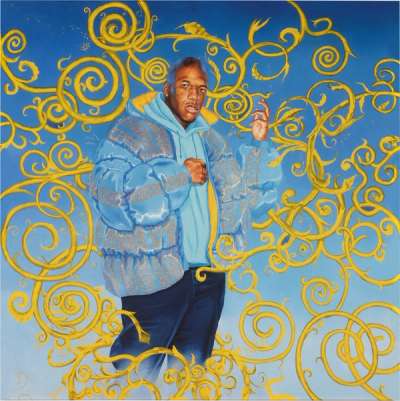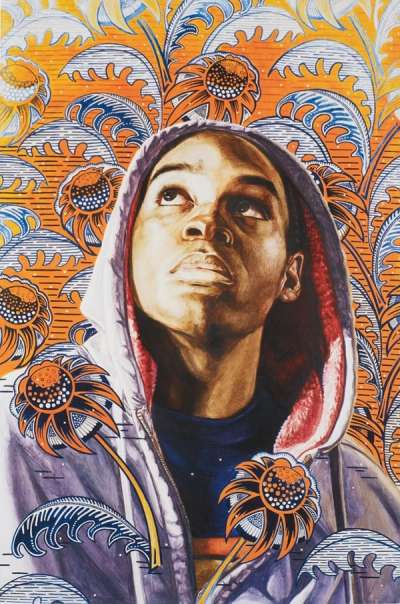Kehinde Wiley's Fusion of French Rococo and Islamic Architectural Motifs

 The Sisters Zénaïde And Charlotte Bonaparte © Kehinde Wiley 2014
The Sisters Zénaïde And Charlotte Bonaparte © Kehinde Wiley 2014
Kehinde Wiley
8 works
Kehinde Wiley, a modern artistic visionary, exquisitely merges French Rococo's lavishness with Islamic architectural motifs. His art, a vibrant tapestry of cultural narratives, initiates a bold dialogue between disparate art movements. Wiley's deep understanding of Rococo's playful luxury, with its flowing curves and intricate ornamentation, beautifully merges with the spiritual, geometric precision of Islamic patterns. He infuses this historical elegance with contemporary energy, elevating subjects from the African diaspora to a status once reserved for past aristocracies. Wiley's work is a dynamic interplay of the traditional and modern, the Western and non-Western, powerfully redefining racial and cultural representation in art.
 Christ After Lady Macbeth II © Kehinde Wiley 2016
Christ After Lady Macbeth II © Kehinde Wiley 2016The Opulence of French Rococo: A Visual Primer
Throughout art history, French Rococo has long stood out for its opulence and decorative finesse. Originating in the early 18th century, this style is a celebration of extravagance and elegance, characterised by its ornate detailing, fluid curves, and a touch of thematic whimsy. Rococo art, with its pastel palettes and light-hearted romantic themes, represents a distinct shift from the grandeur and solemnity of its Baroque predecessor, ushering in an era of artistic freedom and innovation.
The hallmark of Rococo is its intricate design, where asymmetry and natural forms blend seamlessly with motifs of romance and nature. Interiors adorned with elaborate gold leaf and sculptural elements, alongside paintings and tapestries depicting pastoral scenes, are emblematic of this style. Together, these elements combine to create an atmosphere of theatricality and fantasy, a world where art is not just seen but felt.
 Image © Seattle Art Museum / Femme Piquée Par Un Serpent (Mamadou Gueye) © Kehinde Wiley 2022
Image © Seattle Art Museum / Femme Piquée Par Un Serpent (Mamadou Gueye) © Kehinde Wiley 2022Wiley’s Reinterpretation of Rococo’s Exuberance
Wiley, a modern virtuoso in contemporary art, reinterprets the exuberance of Rococo with a flair that is as audacious as it is sophisticated. Born in Los Angeles in 1977, Wiley has garnered acclaim for his large-scale, vibrant oil paintings that redefine traditional portraiture. His unique approach involves the infusion of modern subjects, predominantly African-American individuals, into classical portraiture frameworks, challenging the canon with his oeuvre.
In Wiley’s technique, Rococo's extravagance is reborn, with its intricate patterns and forms serving as a backdrop to subjects who have historically been marginalised in art. This deliberate choice not only revives the Rococo aesthetic but also subverts it, challenging the norms of representation and power dynamics in art. His subjects, posed with an air of nobility and strength, are placed in backgrounds of lush, vibrant patterns and colours that resonate with the opulence of Rococo, yet speak a language that is unmistakably modern and relevant.
Wiley's reinterpretation goes beyond aesthetic appeal to make a bold statement on inclusivity and representation, a reclamation of space in the art narrative for those who have been conspicuously absent. In essence, Wiley’s portraiture is a bridge between epochs, blending the extravagance of French Rococo with the spirit and issues of the contemporary world. His work is a reminder that art is not static but a living, breathing entity that evolves and adapts, reflecting the changing face of society and its times.
 Portrait Of A Venetian Ambassador, Aged 59, II © Kehinde Wiley 2006
Portrait Of A Venetian Ambassador, Aged 59, II © Kehinde Wiley 2006The Significance of Geometric Patterns in Islamic Art
Islamic art is celebrated for its deeply symbolic, precise geometric patterns. These designs, characterised by repeated, interlacing shapes – circles, squares, stars – embody a cosmic significance, representing the infinite, unending nature of the universe. They are a visual expression of spiritual concepts, emphasising unity, order, and the harmonious interconnectivity of all creation.
Wiley's use of these motifs is a deliberate and thoughtful choice. By integrating these patterns, he infuses his work with a sense of timelessness and universality. These geometric designs serve as a backdrop that contrasts and complements the characteristics of Rococo. In Wiley's paintings, these Islamic patterns create a dialogue with the subject and the viewer, inviting contemplation on the interconnectedness of different cultures and artistic traditions.
Islamic Geometric Patterns
Geometric patterns are almost synonymous with Islamic art, involving the creation of complex patterns using shapes like squares, triangles, and hexagons. These patterns are mathematically precise and often represent the infinite nature of creation. They are used to decorate a wide range of surfaces, from walls and floors to ceilings and objects, showcasing the Islamic tradition's emphasis on aniconism and abstraction.
 Kid Ike © Kehinde Wiley 2006
Kid Ike © Kehinde Wiley 2006 Arabesque Patterns
Arabesque patterns consist of rhythmic linear patterns of scrolling and interlacing foliage. These patterns are often combined with other elements like geometric shapes but are more organic in nature. Arabesques symbolise the transcendent, infinite, and indefinable nature of the universe and are a common element in the decoration of Islamic buildings. These patterns are commonly applied in Wiley’s works like Passing/Posing and Kid Ike, where we see his signature curved, interlocked foliage surrounding his subjects.
Muqarnas
Muqarnas or Mocárabe is a form of ornamented vaulting in Islamic architecture. It is characterised by its resemblance to stalactites and is used to create a transition between different architectural elements. This technique is often found in Islamic buildings, where it is used to decorate domes, arches, and vaults, adding a three-dimensional element to the otherwise two-dimensional patterns.
How does Kehinde Wiley combine French Rococo with Islamic motifs?
Wiley’s portraiture fuses the elegance of Rococo with the precision of Islamic motifs, creating a visual language that transcends cultural boundaries. This blend births a technique that speaks to a myriad of themes, from power dynamics to racial identity.
French Rococo reflects a world of leisure and luxury, and in Wiley's work, it manifests in the fluid backgrounds, the swirling drapery, and the rich, decorative elements that frame his subjects. In Tomb Of Pope Alexander VII Study I, we see a portrait of a young black male seemingly enveloped by the Rococo foliage that surrounds him. While functioning solely as a background agent, this design offers a whirlwind of beauty to the portrait, however given the context of Wiley’s portraiture, this work reveals a deeper message: that the subject clothed in it, is worthy of being covered in beauty, and be associated with its proximity.
 Image © Brooklyn Museum / Two Heroic Sisters of the Grassland © Kehinde Wiley 2011
Image © Brooklyn Museum / Two Heroic Sisters of the Grassland © Kehinde Wiley 2011In stark contrast yet harmonious coexistence, Wiley integrates Islamic motifs, renowned for their detail and spiritual symbolism. His use of these motifs is a nod to structure and continuity, offering a visual anchor in his otherwise fluid compositions. We see this in works like Two Heroic Sisters Of The Grassland, where the subjects are set against a backdrop of meticulous patterns reminiscent of Islamic mosaics, except this time, they’re through Wiley’s eyes, creating a juxtaposition between the free-flowing Rococo elements and the orderly, architectural designs.
Wiley’s combination of these two distinct styles allows him to challenge and redefine traditional power structures within art. By placing contemporary Black subjects within these historically charged contexts, he subverts the conventional narratives of who is represented in art and how. His work becomes a cultural dialogue, a reclamation of space and narrative, giving voice and visibility to those historically marginalised within the art ecosystem.
 Image © Brooklyn Museum / Napoleon Leading The Army Over The Alps © Kehinde Wiley 2005
Image © Brooklyn Museum / Napoleon Leading The Army Over The Alps © Kehinde Wiley 2005Wiley’s Portraits: A Canvas for Cultural Dialogue
Wiley's oeuvre transforms the canvas into a dynamic arena where contrasting ideologies and histories converge, creating a dialogue that transcends the traditional confines of art. His unique approach blends the ornate flamboyance of French Rococo with the geometric precision of Islamic motifs, crafting a deliberate and thoughtful cultural synthesis. Wiley's portraits, rich in diversity and complexity, challenge viewers to confront and reassess their perceptions of identity and power. Through his art, Wiley weaves a narrative that defies geographical and temporal boundaries, advocating for an understanding that appreciates both the uniqueness of individual cultures and the shared experiences of humanity. His work celebrates cultural diversity, presenting a visual experience that compels the viewer to engage with the intricacies of identity in a globalised context.
A striking example of Wiley's ability to merge historical reference with contemporary narratives is his Christian Martyr Tarcisius (2008), which made its auction debut in March 2024. Inspired by Alexandre Falguière’s 1868 sculpture Tarcisius, martyr chrétien, Wiley reimagines the youthful martyr against a backdrop of vibrant blue and pink florals. This monumental work achieved a record-breaking sale of over £660,000, more than doubling its estimate. Through such works, Wiley not only celebrates the vibrancy of his subjects but also reclaims and recontextualises spaces historically denied to them, offering a commentary on identity, representation, and cultural synthesis.
The Subjects and Symbolism Behind the Style
Wiley's artistry is a masterclass in symbolic representation, blending historical context with contemporary relevance. His subjects, primarily from the African diaspora, are emblematic figures reclaiming spaces and stories historically denied to them. Wiley’s choice of subjects in regal poses against ornate backdrops is a deliberate subversion of the conventional art canon, where such representation was reserved for the affluent and European aristocracy.
Wiley's infusion of contemporary clothing and styling into these traditionally styled portraits adds another layer of symbolism. It bridges the gap between past and present, showcasing the continuity and evolution of cultural identity. His work is a celebration of diversity, reflecting a world where cultural exchanges are fluid and boundaries are increasingly blurred. Wiley’s canvases become a space where history is not only acknowledged but also reinterpreted, offering a new perspective on the narratives that shape our understanding of art, culture, and identity.
Celebrating Diversity and Complexity in Artistic Expression
By merging cross-cultural aesthetics, Wiley creates a visual language that is both universal and deeply personal. His work underscores the richness that diversity brings to the world of art with portraits revealing stories of resilience, pride, and beauty. In Wiley's universe, every brushstroke is an act of defiance against the homogeneity of traditional art, a vibrant assertion of the variety that defines our world.
His attention to detail, whether in the intricate lacework of a garment or the elaborate background patterns, demonstrates a deep respect for the craftsmanship inherent in both Rococo and Islamic art. This respect is evident in the way he carefully preserves the integrity of each style while bringing them together in a contemporary context. Wiley's legacy is not just in the images he creates but in the conversations he inspires – conversations about race, representation, and the role of art in our lives. His celebration of diversity through the fusion of various artistic traditions not only enriches the art world but also mirrors the ever-changing landscape of human expression.






















